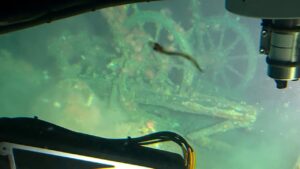Ramón Larramendi and team covered nearly 2000 km with wind power only
End of June, the Windsled, led by explorer Spaniard Ramón Larramendi, has successfully completed its journey of 1,870 kilometers, a route that has led the sled to ascend up to an altitude of 3,000+ meters, and that has lasted six weeks. The team arrived at Kangerlussuaq on the southwest coast of Greenland by helicopter, after meltwater and cracks in the ice prevented them to stop right at the edge of the Ice Cap.
During the expedition, which had scientific and exploration objectives, it has been proven that the wind vehicle, one of a kind in the world, designed by Larramendi, is able to navigate the Arctic territories carrying two tons and up to six crew, said the press release.
The Windsled, with dimensions of 12 meters long by three and a half wide, was able to make an ascent with headwind from near the Southwest Coast, reaching the 3,240 m ‘summit’. From there, the team began the descent towards the East coast, where a helicopter landed close to the vehicle for the change of part of the crew. On this part of the route they travelled faster, sometimes exceeding 25 km/h, without major incidents, compared to the wind callenges towards the Summit.
From the East they began the last phase of the journey, back to the West side. This last 500 km was without problems, they reported, until they reached the Western Icefall. The most difficult time for the Windsled was in the last hours, when the sled had to cross an area of large cracks, covered by snow. This changed the last kilometers in a ‘land-mine’, fortunately without consequences.
In the West-East section, Hilo Moreno, Ignacio Oficialdegui, Vicente Leal, Karin Moe Bojsen and Nacho Garcia accompanied Ramón. The last four were replaced, as planned, after 1,500 kilometer by Manuel Olivera, Malik Milfeldt and Miguel Herrero.
During the route, the members of Expedition Tierras Polares have collected data about the ice and snow conditions; on cosmic radiation for the scientists from the CSIC and the University of Alcala de Henares.
Once on the ice summit, at the American scientific base, Summit Camp (or Summit Station), they also collected scientific instruments for another research, in this case led by the American glaciologist Jason Box, from the Geological Survey of Denmark. With this material, the expeditioners drilled to depths of 13.5 meters in different geographic coordinates of the Greenland interior for climate change studies.
Ramón Larramendi’s expedition, in which nine people participated, the nearly 2,000 kilometer journey started from the Southwest coast near Kangerlussuaq (Lat: N 67º 009‘ Long: W 050º 43’) and headed towards the highest point of the interior ice desert (Inlandis) where the scientific USA Summit Camp base is located. From there they went down towards the Southeast coast, direction Isortoq. From the East, the team return across the Ice Cap via the Cold War Station, DYE II.
The new prototype of Windsled has been experimented with, with significant improvements compared to the one used in the 2014 Greenland Circumnavigation, stated the website.
Previous/Related
Greenland Ski World Record: Effort and Mental Approach (Western Icefall mayhem of waterways)
Windsled sites:
https://greenland.net/windsled/
https://greenland.net/windsled/greenland-ice-summit-expedition-2016/
https://www.facebook.com/ramonlarramendi/
https://greenland.net/windsled/expedition-step-by-step/
https://www.tierraspolares.es/trineodeviento/bitacora-de-viaje/ (Spanish)
#Greenland #windsled





